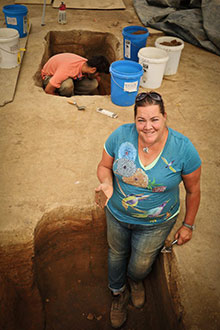STEM Careers: Archaeologist
Archaeologists are scientists who study human history and culture by digging up artifacts from the past.
Meet Ruth Mitchell.

Image courtesy of Historic St. Mary’s City
“As an archaeologist I work with a team to find and excavate sites. To excavate a site we have to carefully clean the soils and identify cultural features, such as fences or post holes that were once part of the landscape. Clues are hidden in the soil and we carefully examine these to help understand the past. Discovering artifacts is an important part of our work because the objects can help tell the story of what kind of site we are uncovering and what time period a site might date to. Every day we carefully record and map our finds so there is a permanent record of our work, and so we can keep track of where objects and features are from. Although archaeology is a social science, we use many methods related to the STEM program. Geometry is used extensively for gridding the site and mapping what we find. Geology and soil science inform us about the soils we excavate and the features they contain. Like biology and zoology, we used concepts of typology to classify the materials recovered.”
